
Want to use your high-end dual monitor setup with two different computers? All you need is a specific KVM switch for dual-monitor setups and two computers that both support multiple monitors. Whether that second machine is for work, streaming, or running a home media server, it becomes a whole lot more useful when it doesn’t need its own keyboard, mouse, and display (never mind the space on your desk). Find the best KVM switches for a dual monitor setup in our buyer’s guide below.
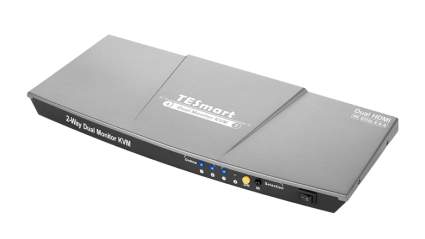
|
Amazon Customer Reviews
|
Price: $159.99 Shop at Amazon | Shop now Read our review |
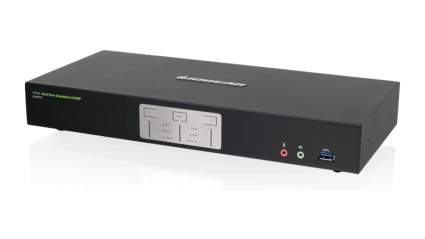
|
Amazon Customer Reviews
|
Price: $291.70 Shop at Amazon | Shop now Read our review |
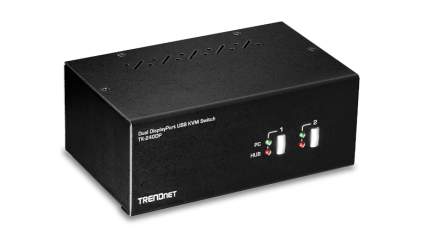
|
Amazon Customer Reviews
|
Price: $189.15 Shop at Amazon | Shop now Read our review |
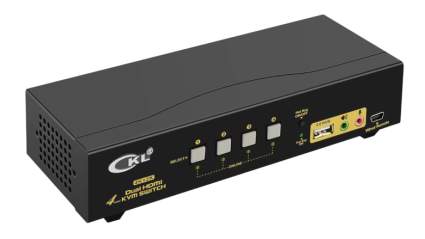
|
Amazon Customer Reviews
|
Price: $199.00 Shop at Amazon | Shop now Read our review |
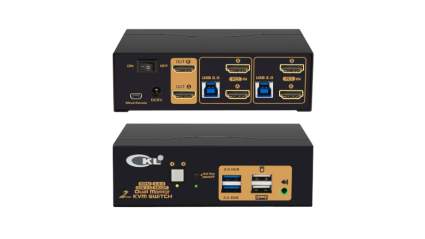
|
Amazon Customer Reviews
|
Price: $129.99 Shop at Amazon | Shop now Read our review |
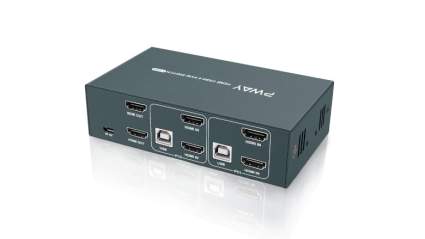
|
Amazon Customer Reviews
|
Price: $69.99 Shop at Amazon | Shop now Read our review |
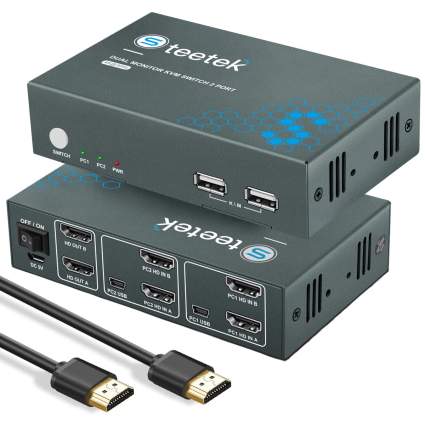
|
Amazon Customer Reviews
|
Price: $39.99 Shop at Amazon | Shop now Read our review |
-
1. EDITOR’S CHOICE: TESmart HKS0402A1U
Pros:- Supports 4K UHD @ 60Hz
- USB 2.0 hub
- Included IR remote
Cons:- No USB 3.0 ports
- HDMI monitor required for audio
- No 3.5mm mic port
One of the most important features of a KVM switch is the speed in which it switches from one input to another. And while there are many different factors to consider when picking a KVM switch for your home office, the TESmart HKS0402A1U stands out as the all-around best pick for any PC that has native support for dual HDMI connections. It offers fast switching between two source machines and is capable of delivering 4K video to two monitors at 60Hz.
This KVM switch comes with all necessary cables as well as a wireless IR remote that can be used to swap sources from across the room. Alternatively, you can use the onboard switch button or the scroll lock button on your keyboard. The switch has three USB 2.0 inputs, two of which are meant to connect your keyboard and mouse, and one is for extra peripherals. You can connect a USB hub to this port if you need additional devices but note that it won’t transfer data as quickly as a USB 3.0 port would. Also, note that you should only connect a USB hub with dedicated power.
The TESmart HKS0402A1U is a great way to streamline your desktop setup by minimizing your need for a second keyboard, mouse, and monitor. And if you want to get even more mileage out of your keyboard, you can also consider browsing our list of the best keyboard and mouse adapters for gaming consoles.
Dimensions: 6.3 x 3.1 x 0.4 inches
Inputs: 2 HDMI+HDMI, 3 USB 2.0
Outputs: 1 HDMI+HDMI, 2 USB 3.0
Max resolution: 3840 x 2160 @ 60HzFind more TESmart HKS0402A1U KVM Switch information and reviews here.
-
2. Best DisplayPort KVM Switch: IOGear GCS1942
Pros:- Supports True 4K @ 60Hz
- USB 3.0 hub
- Shared 3.5mm mic inputs/outputs
Cons:- High price tag
- Mediocre audio quality
- No remote control
Though your dual monitor KVM switch options are somewhat slimmer if your machine natively supports DisplayPort instead of HDMI, you still have access to top-of-the-line gear like the IOGear GCS1942. This hardware controller has all the features you could ask for, including two USB 3.0 ports for your keyboard and mouse, plus an additional USB 3.0 port for connecting other peripherals. It also supports True 4K (4096 x 2160) at a refresh rate of 60 Hz, which is great if you have 4K monitors at home or ever want to upgrade.
The GCS1942 comes with all of the cables you’ll need for your setup, including four DP. However, you may have to change some settings to get this KVM switch working if you have a particularly fancy keyboard or mouse. In this case, the manual suggests that you preemptively disable both mouse and keyboard emulation (which are on by default). This is done by pressing Scroll Lock + Scroll Lock + M + Enter and Scroll Lock + Scroll Lock + N + Enter, respectively.
This KVM switch has microphone and speaker inputs/outputs so you can share audio devices between machines too. That said, some reviewers have reported background noise from pathing their audio through the switch, but this doesn’t appear to be the norm. The only other complaint I have about this switch is that it would be nice to get a remote control considering the price tag of the unit. But other than that, there is little to dislike about the IOGear GCS1942.
Dimensions: 13.2 x 6.1 x 2.1 inches
Inputs: 2 DisplayPort+DisplayPort, 3 USB 3.0, 3.5mm
Outputs: 1 DisplayPort+DisplayPort, 2 USB 3.0, 3.5mm
Max resolution: 4096 x 2160 @ 60HzFind more IOGear GCS1942 KVM Switch information and reviews here.
-
3. Best KVM Switch for Gaming: TRENDnet TK-240DP
Pros:- Supports 2K UHD @ 144Hz / 4K UHD @ 60Hz
- Shared 3.5mm mic inputs/outputs
- USB 2.0 hub
Cons:- No USB 3.0 ports
- No included cables
- Does not support cable adapters
If your workspace houses both a gaming PC and a work PC, then you should be mindful that using a KVM switch might cost you frames or resolution. That’s why we recommend the TRENDnet TK-240DP KVM switch for use with a gaming rig, especially if it uses monitors with 4K resolution or 144 Hz refresh rate.
The TK-240DP is one of only a few dual monitor KVM switches we found that supports both of these specs, though not simultaneously. You can set this switch to either 3840 x 2160 4K UHD at 60Hz or 2560 x 1440 2K UHD at 144Hz, which is more or less as good as it gets for consumer-grade equipment. The 144Hz mode is also compatible with Nvidia GSync and AMD FreeSync display technologies.
This KVM switch connects to two PCs via dual DisplayPort connections. This is important to note as the manufacturers of the TK-240DP advise against using any adapters or conversion cables in your setup. If this stands to be a problem with your setup, you could always consider the TESmart HKS0401A2U, which has native HDMI support. Also note that the TK-240DP doesn’t come with any cables, so you will need to provide your own DisplayPort 1.4 cables and USB A-to-B cables.
As for peripheral support, the TK-240DP has two dedicated USB ports for a keyboard and a mouse plus two additional USB 2.0 ports for other shared peripherals. It also has microphone inputs/outputs so two PCs can share one microphone. There are speaker inputs/outputs too but this is the case for every KVM switch reviewed since HDMI inputs have audio built-in.
Dimensions: 6.4 x 6.9 x 2.6 inches
Inputs: 2 DisplayPort+DisplayPort, 4 USB 2.0, 2 3.5mm
Outputs: 1 DisplayPort+DisplayPort, 2 USB 2.0, 2 3.5mm
Max resolution: 3840 x 2160 @ 60HzFind more TRENDnet TK-240DP KVM Switch information and reviews here.
-
4. Best KVM Switch for 3 PCs: CKL 923HUA
Pros:- Supports up to 4 PCs
- Supports 4K UHD @ 30Hz
- USB 2.0 hub
Cons:- No USB 3.0 ports
- Poorly handles multi-OS setups
- No 60Hz support
Do you have two monitors and three PCs? If so, you’ll need a sufficient HDMI KVM switch like the CKL 942HUA to share your peripherals and displays with all of them. Since three-way KVM switches are quite uncommon, this KVM switch can technically support four PCs, but let’s not get too crazy before we even cover the basics.
The CKL 942HUA is surprisingly easy to connect thanks to its included custom cables that convert HDMI to USB and 3.5mm. This is great for making a clean cable setup at your workstation but not so great if you have to replace these specialized cables for any reason. Plus, it means that this dual monitor KVM switch also supports microphone input/output. To add, you also get three USB 2.0 ports. Two are dedicated to a keyboard and mouse and one is for anything else you might need (or you can add a powered USB hub if you need to share multiple peripherals).
The buttons to swap machines are easy to access from the front of the switch box but you can also use a mouse or keyboard hotkey or the included wired remote. Switching takes a few seconds but this is a minor inconvenience at most. Though, be warned that this switch doesn’t always play nice with Mac or Linux operating systems, so be prepared for some extra issues if you aren’t 100% on Windows.
Dimensions: 7.9 x 3.0 x 1.7 inches
Inputs: 4 HDMI+HDMI (custom cables)
Outputs: 4 HDMI+HDMI
Max resolution: 3840 x 2160 @ 30HzFind more CKL 923HUA KVM Switch information and reviews here.
-
5. Best USB 3.0 KVM Switch: CKL 923HUA-3
Pros:- USB 3.0 hub
- Supports 4K UHD @ 60Hz
- Included wired remote
Cons:- Poorly handles multi-OS setups
- No 3.5mm mic port
- Doesn't include all cables
Though the CKL 922HUA-3 is not the only KVM Switch on this list with a USB 3.0 hub, it stands out for having not one but two onboard USB 3.0 ports. This could potentially eliminate the need to chain on a powered USB hub (unless you absolutely need more than two USB 3.0 accessories). On top of this, it also supports 3K UHD output at a refresh rate of 60Hz.
Setting up the CKL 922HUA-3 is pretty much a matter of plug and play as long as you are using Windows on both devices. It will still work with a Mac or Linux machine but this may require extra setup. The inputs and outputs on the back are clearly labelled but it should be noted that this device doesn’t ship with all the necessary cables in the box. You will be short two HDMI cables, but this shouldn’t be a problem if your monitors came with cables. And it would be quite peculiar if they didn’t.
There are multiple ways to switch machines, including a keyboard hotkey, a mouse hotkey, dedicated buttons on the front, and an included wired remote. Switching machines takes a few seconds but this is to be expected of a dual monitor KVM switch at this price point. All in all, the CKL 922HUA-3 is a solid choice for anyone with a lot of USB accessories.
Dimensions: 9.4 x 5.2 x 4.0 inches
Inputs: 2 HDMI+HDMI, 2 USB 2.0, 2 USB 3.0
Outputs: HDMI+HDMI, 2 USB 3.0
Max resolution: 3840 x 2160 @ 60HzFind more CKL 923HUA-3 KVM Switch information and reviews here.
-
6. Best Cheap Dual Monitor KVM Switch: Pway S7201H2
Pros:- Supports 4K UHD @ 30Hz
- USB 2.0 hub
- All cables included
Cons:- No USB 3.0 ports
- No 60Hz support
- No 3.5mm mic port
If you are looking for a dual monitor KVM switch that won’t break the bank, the Pway S7201H2 KVM Switch is our top budget choice. This device performs most of the essential functions you may need without extravagant features like USB 3.0 ports and high refresh rate support. That said, it still supports 4K UHD output and has four USB 2.0 ports so it isn’t totally bare bones.
The Pway S7201H2 comes with all necessary cables to hook two PCs up to two monitors. Just make sure that both PCs natively support dual HDMI connections. You’ll want to avoid using adapter cables if possible as they can sometimes cause issues, but this is far from the most finicky model we’ve tested. It works decently with other OSes too including Mac OS and Linux.
Switching between machines is easy as you can use either the onboard switch or a keyboard hotkey. The hotkeys are Scroll Lock+Scroll Lock+1/2 or Ctrl+Ctrl+1/2 and I am telling you this here because the physical documentation isn’t very good. But that is a small concession to make for the sheer value that the Pway S7201H2 offers.
Dimensions: 9.0 x 6.7 x 3.0 inches
Inputs: 2 HDMI+HDMI, 4 USB 2.0
Outputs: 1 HDMI+HDMI, 2 USB 2.0
Max resolution: 3840 x 2160 @ 30 HzFind more Pway S7201H2 KVM Switch information and reviews here.
-
7. Another Cheap Option: Steetek Dual Monitor KVM Switch
Pros:- HDMI Connectivity
- Seamless Switching
- Efficient Multitasking
Cons:- Cable Management Required
- Audio LImitations
- Looks Like Dated Technology
The Steetek Dual Monitor KVM Switch is a versatile device designed for users who require simultaneous control over two computers using a single set of peripherals. With this switch, you can conveniently manage two computers with dual monitors, enhancing productivity and streamlining your workspace.
The KVM switch supports various computer systems and is compatible with both Windows and Mac operating systems, ensuring broad compatibility. It offers seamless switching between computers using hotkeys or push buttons, allowing you to transition effortlessly between tasks and systems.
Equipped with two HDMI ports, USB ports for keyboard and mouse connectivity, and audio jacks, the Steetek KVM switch provides comprehensive connectivity options. The inclusion of HDMI ports enables high-definition video transmission, ensuring crisp and clear display quality on your dual monitors.
Installation is straightforward with the included cables and does not require any additional software. The switch also supports hot-plugging, enabling you to add or remove devices while the switch is in operation without disruptions.
The Steetek Dual Monitor KVM Switch is designed with a compact and durable housing, making it ideal for desktop or office environments. Its reliable performance and efficient operation make it a valuable tool for professionals handling multiple computers and monitors simultaneously.
Find more Another Cheap Option: Steetek Dual Monitor KVM Switch information and reviews here.
What is a Dual Monitor KVM Switch Used For?
With more people working from home, it is increasingly common for individuals to have both a work computer and a personal computer at home. If, however, you are a PC enthusiast with a nice dual monitor setup then you will save space, money, and time if you can use that dual desktop environment for both machines. The same applies for a nice mechanical keyboard and/or a macro-capable mouse.
That's where a Dual Monitor KVM switch comes into play. This box allows several devices to share one set of monitors as well as some USB peripherals. This works best when both devices can support multiple displays but they can still be useful even if only one of the devices supports two displays.
Some enterprise KVM switches can share a display between dozens of computers and even connect to PCs over IP but we stuck to simpler setups that would be useful in a home office setting. If, however, additional device support or KVM-over-IP is a requirement for you, these things do exist.
Do You Really Need a KVM Switch?
In most cases, a KVM switch is clearly preferential to all alternatives but this is not always the case. There are a few niche scenarios where you might not need a KVM switch to manage two computers.
For starters, if you have a spare monitor, mouse, and keyboard available as well as space on your desk, then there is no reason why you can't just set two PCs up side by side. It may be messy but it makes use of what you have.
Second, some degree of peripheral sharing can be achieved using remote connection software. This article from makeuseof.com denotes several software alternatives for a physical KVM, though note that some don't support multiple monitor setups.
For most purposes, though, a dual monitor KVM switch is the preferred tool for streamlining your home office.
Are KVM Switches Secure?
Not all KVM switches are secure, but there are multiple secure KVM switches available, like this one.